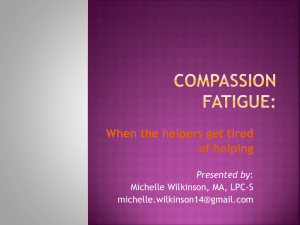PowerPoint - Guidance Expo
advertisement
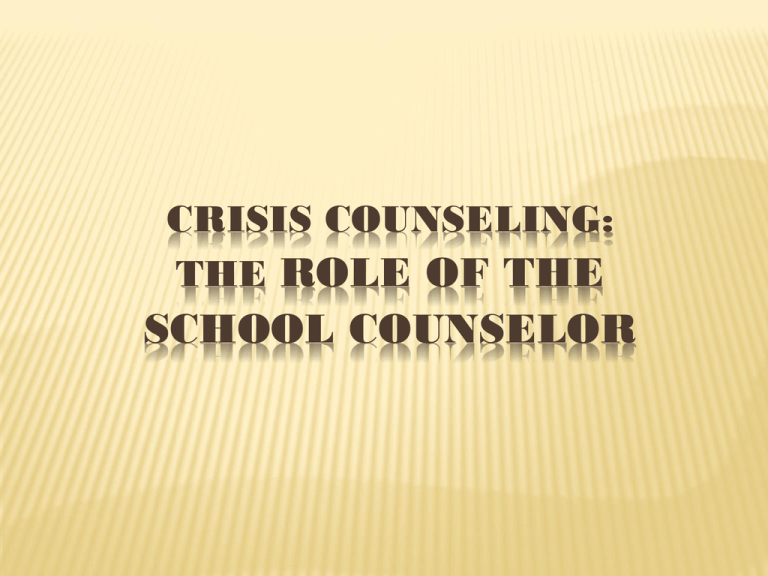
CRISIS COUNSELING: THE ROLE OF THE SCHOOL COUNSELOR Presenters Professor Robert G. Stevenson, Ed.D. Professor Arthur G. McCann, Ph.D. Mercy College School of Behavioral and Social Sciences Graduate Counseling Programs PRESENTATION OBJECTIVES Define a crisis Contrast personal and group crisis Review the lifecycle of a crisis Identifying the counselor’s role in assisting those dealing with personal crises A CRISIS A crisis is a turning point. It is often marked with instability or danger and can lead to a decisive future change That change can be for better or for worse. It can also be a dramatic upheaval in a person’s life. It is seen by those involved as serious – needing an immediate decision or action. GENERAL TYPES OF CRISES PERSONAL – A perception or experiencing of an event or situation as an intolerable difficulty that exceeds the person’s current resources and coping mechanisms. GROUP – A situation that holds the potential for either disaster or opportunity. REACTION TO PERSONAL CRISIS Individuals facing a crisis may: Cope by themselves and grow stronger from the experience Survive the immediate crisis, but block it from consciousness, possibly leading to future problems Break down from the crisis – putting life on hold unless they receive immediate assistance LIFE CYCLE OF A CRISIS Prepare Mitigate Respond Recover CRISIS CHARACTERISTICS Every crisis is complicated The disequilibrium of crisis provides impetus for change (+/-) Brief therapy can help – and is appropriate in schools, but it treats symptoms, not the cause(s) and may not be enough by itself. Choice is essential Crisis is “universal” because no one is immune. Crisis can be time limited (6-8 weeks). PLANNING FOR A CRISIS Be prepared to ask the right questions (what, where, when, how and, in some cases, why) Identify the precipitating event(s) Establish goals and operational definitions Create a crisis response plan with clearly identified steps Create and implement response protocols Begin ongoing evaluation and mitigation A ASSIGNING “MEANING” It is important for a counselor to understand the meaning a person assigns to an event or an emotion. These meanings may be seen as any of the following: • A Challenge – to be overcome • A Loss – making change difficult or impossible • A Gain – a sign that one is working to maximum ability • A Punishment – penance for not doing something right (or for doing something wrong) in the past • A Reality – to be assessed and dealt with so that it can be reduced to an acceptable level A ASSESSMENT “A–B–C” Affect – abnormal or impaired affect is a sign of disequilibrium Behavior – immobility impairs behavior so doing something concrete helps forward movement Cognitive state – has the crisis been made worse by rationalizing, exaggerating or faulty belief(s) ASSESSMENT TRIAGE Affect: Anger/Hostility Fear/Anxiety Sadness/Melancholy Behavior: Approach Avoidance Immobility Cognition: Transgression (present) Threat (future) Loss (past) CRISIS INTERVENTION MODELS The model you select needs to assess and address: Equilibrium – disequilibrium creates a need to regain stability Cognition – faulty thinking may need to be changed Psychosocial Transition – internal and social change may create a need for new internal coping mechanisms that are adequate to the demands of the crisis SIX STEP MODEL OF CRISIS INTERVENTION Assessing (done throughout counseling) Listening 1. Define the problem and set goal(s) 2. Ensure client safety 3. Provide support Acting 4. Examine alternatives 5. Make plans 6. Obtain commitment and take action A LISTEN FOR AND USE: Open-ended questions Closed-ended questions Statements showing owning feelings Disowned statements Statements conveying understanding Value judgments Positive reinforcement Empathy, genuineness, acceptance A TAKING ACTION: See individual differences Assess yourself Acknowledge client safety Provide client support Define the problem and set goal(s) Consider alternatives Plan action steps Use client coping strengths Attend to client’s immediate needs Use referrals (when appropriate) Develop and use networks Get a commitment to action from the client A YOUR ROLE AS A COUNSELOR: Listen to concerns Assess safety needs of the client Make owning and assertive statements about your role Deal with current client functioning concretely and objectively Speak clearly, in the present, about the problem Take immediate, direct action to restore mobility and equilibrium SCHOOL COUNSELOR INTERVENTIONS WITH GRIEVING STUDENTS Be proactive in providing help. Encourage student to draw support from friends and family. Encourage self-care (exercise, rest and healthy diet.) Listen without judging. Encourage talking about loss, while being mindful of the stages of grief (denial or shock, fear, anger, guilt, depression or sadness, and acceptance.) Invite sharing of memories. Encourage talking about loss. (Externalizing inner “pressure.”) Invite sharing of memories. Encourage resumption of normal activities. (Source: List 7.18 Dealing with Grief and Loss in The School Counselor’s Book of Lists, second edition) COUNSELOR’S ROLE IN HELPING TEACHERS WHEN A STUDENT DIES When speaking with bereaved parents, be supportive, only give suggestions when requested, ask what they would like shared with other students. Offer to visit class to tell the students what happened. Prepare the teacher (or offer to collaborate) to tell classmates. Match information with the students’ developmental ability to understand. Communicate that life is precious and precarious. If death is by suicide, do not glorify and do not try to explain why it happened. Be truthful, honest and accepting. Coordinate follow up steps with teacher and administrator. Inform the faculty in the way the parent(s) or guardian(s) desires [if possible]. Pay special attention to siblings and special friends of the deceased child. (Source: List 7.20 Dealing with Grief and Loss in The School Counselor’s Book of Lists, second edition) SURVIVING AND MOVING ON Help the student to: Accept the loss(es). Be aware of feelings Externalize emotions. Draw on personal beliefs. Understand negative coping Utilize every resource (because there is seldom one correct answer to most of the questions that arise) RECENT LITERATURE FROM ASCA An edition of School Counselor (September/October, 2011, Vol. 49, No. 1) entitled: Crisis in the Schools: Natural Disasters, Terrorism, Violence and Death – Help Students Prepare, Adjust and Move on. This issue contains five articles that identify practical and worthwhile steps that School Counselors can take to help in times of crisis. A SUPPORT TRAUMATIZED STUDENTS BY ROBIN H. GURWITCH, PH.D. AND DAVID J. SCHONFELD. M.D. To help students address and deal with traumatic incidents: 1. Initiate the Conversation. 2.Validate Feelings and Experiences. 3. Answer Questions and Correct Misinformation. 4. Educate Students and Caregivers about Common Reactions. 5. Help Students Identify Positive Coping Strategies. 6. Identify Triggers or Reminders. 7. Encourage return to Extracurricular Activities. 8. Encourage Activities That Promote Help and Healing 9. Maintain Regular Communication with Teachers and Caregivers. 10. Be Available for the Immediate, Short-Term, and Long-Term counseling. A OTHER ARTICLES IN SCHOOL COUNSELOR Kids Supporting Kids by Kathleen S. Tillman, Ph.D. and Jonathan P. Rust – Learn to implement a 10-stage model for running grief and loss groups in your school. Youth in Crisis by Jeannine R. Studer, Ed.D. – By using a problem-solving model, you can help students move on from the traumatic incidents in their lives and learn to effectively cope with any that may come down the road. Childhood Observers of Domestic Violence by Kenneth W. Elliott, LMFT, CCDVC and Judith Elliott, LCSW, ACSW – Children exposed to domestic violence often exhibit reactions similar to physically abused children. Discover guidelines for helping these children to cope. Five Steps to Prepare – by Cheri Lovre - Everyone in the building has a role to play in the event of an emergency. Make sure you’ve done your part to ensure your school building and students are ready for emergency responses. A PREVENTING “COMPASSION FATIGUE” Compassion - A “feeling of deep sympathy and sorrow for another who is stricken by suffering or misfortune, accompanied by a strong desire to alleviate the pain or remove its cause.” (Webster’s, 1989, p.229). Compassion Fatigue - (aka, secondary traumatic stress, nearly identical to PTSD, vicarious traumatization) - This is similar to emotional contagion, “…defined as an affective process in which an individual observing another person experiences emotional responses parallel to that person’s actual or anticipated emotions.” ( Figley, 2002) Compassion Satisfaction – Stamm (2002) has identified this as a protective factor, a positive side of compassion that counterbalances the negative. She developed a Compassion Satisfaction and Fatigue (CSF)Test to help estimate risk of burn out and compassion fatigue. A PREVENTING “COMPASSION FATIGUE” (CONTINUED) Develop our capacity for humor. Gain a sense of achievement and satisfaction from setting achievable work standards. Acquire adequate rest and relaxation. Develop and regularly incorporate an array of stress reduction methods into our repertoire. Let go of work. Apply Critical incident stress debriefings and stress management (CISD/M ) plans and actions as needed when crises arise. (Source: Treating Compassion Fatigue edited by Charles R. Figley, 2002) A RESOURCES Blum, D.J. and Davis, T.E. (2010). The School Counselor’s Book of Lists, 2nd edition, San Francisco, CA: Jossey-Bass. Federal Emergency Management Agency (FEMA) http://training.fema.gov/IS/ Figley, C.R., ed. (2002). Treating Compassion Fatigue, New York , NY: Brunner-Routledge. James, R. K. and Gilliland, B. K. (2004). Crisis Intervention Strategies 5th edition, Brooks/Cole. Stevenson, R. G., ed. (2002).What will we do? Preparing the school community to cope with crises, 2nd edition, Baywood Publishing. Stevenson, R.G. and Cox, G. ed. (2007). Perspectives on Violence and Violent Death Amityville, NY: Baywood Publishing. EMPOWERING OBJECTS AMULET – an object (such as a horseshoe) that wards off evil. TALISMAN- an object that enables the one who possesses it to accomplish great deeds. In some cases, one object may serve as both amulet and talisman. OPERATIONAL DEFINITIONS CRISIS – a serious or decisive state where an action will have positive or negative consequences. CRISIS COUNSELING – a process that has as its focus the emotional ramifications of a crisis. CRISIS INTERVENTION – steps to address the immediate problem using a variety of resources.
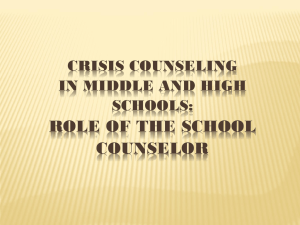
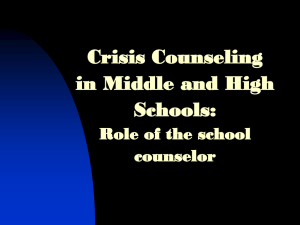
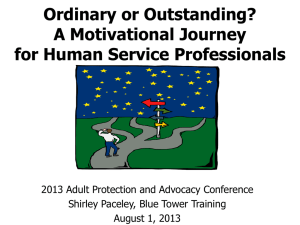

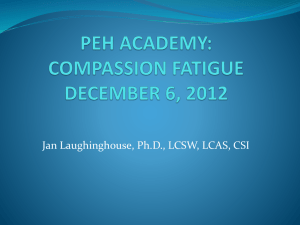
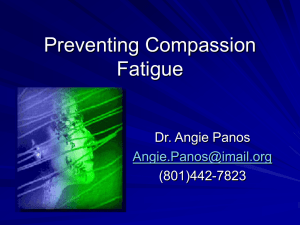

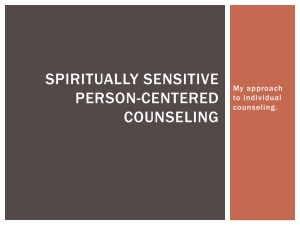
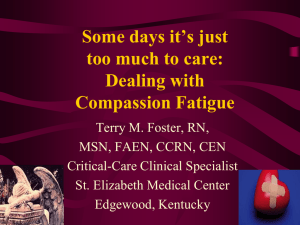
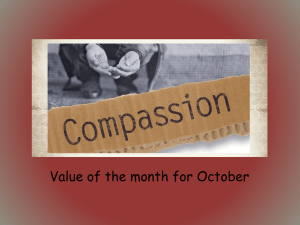
![Welcome and keynote [PPTX] - University of California](http://s2.studylib.net/store/data/005379330_1-defe5a320244e6e9135ed98fd0853e39-300x300.png)
